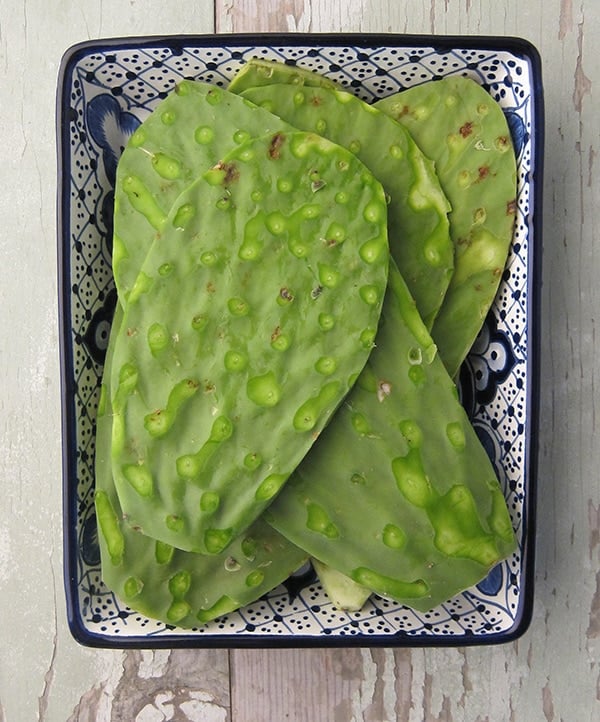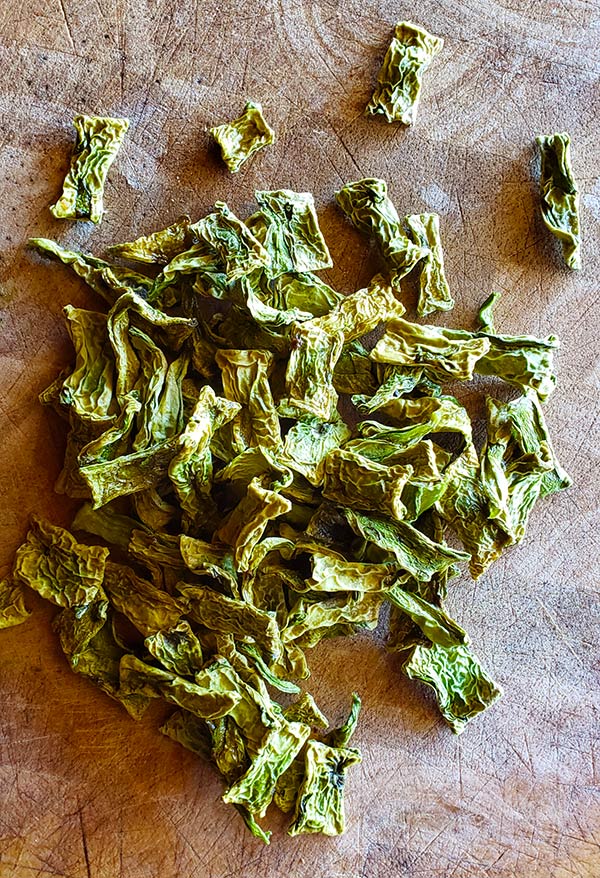As an Amazon Associate I earn from qualifying purchases.

Cooking nopales without slime is the end goal of, well, I’d say almost everyone who cooks the paddles of the prickly pear cactus.
I get it. Nopales are a vegetable with twin barriers: First, you need to clean nopales to remove the spines. Then you need to remove the slime they exude, especially once the nopales hit water. Think okra with a runny nose.
Once you get there, however, they are fantastic. Crunchy, tart, like lemony green beans. Nopales (pronounced “no-PAH-les”) are good pickled, dried and reconstituted for soups and stews, grilled, added to salsas, etc.
But that slime! The Mexicans call it babas. Fortunately there are many ways to remove it.
When you eat raw nopales, you will want to toss them in fine sea salt for about 10 minutes first. Maybe a tablespoon or two per large paddle. Dice or slice the nopales how you plan to eat them in a salad, then put them in a bowl and toss with the salt.
Move to a colander for 10 to 20 minutes to drain, then rinse under cold water, vigorously rubbing the nopales to remove all the slime. You’re good to go for your ensalada de nopales.
Now that we have raw down, how to cook nopales without slime?

A Few Tricks
- First, the old abuelas tale about putting the husk of tomatillos in the water when you boil nopales actually works. I have no idea how, but it does. I boil however many nopales, diced or whatever, as I plan to eat, in salty water with the husks of about 3 to 6 large tomatillos, for about 10 minutes. Drain and proceed.
- Baking soda. Adding a healthy pinch of baking soda near the end of boiling works pretty well. Boil your nopales in salty water for 10 minutes, as in the previous method, but add the baking soda in the last 3 to 5 minutes. Be careful, though, because it can make the water froth over — so make sure you have some room in your pot for the water to expand.
- Grill them. If you cross-hatch a nopal, just scoring the skin, not actually cutting through the paddle, and grill it, the babas will seep out and evaporate over the fire. Grilled nopales are fantastic.
- Bake them. This is a Rick Bayless trick. Preheat an oven to 375°F. Dice your nopales and toss with a little salt, as much as you’d want just to season them (so a lot less than when you prep them raw). Arrange in one layer on a baking sheet and bake about 20 to 30 minutes. The slime will ooze out and dry up.
- Saute them. Doing this requires some faith and a little patience. If you have a stir fry or saute with nopales, all will go well, until the babas flows. There will be a moment when everything in your pan is snotty and nasty. Hang in there. It cooks away. Once it does, you’re good to go.
- Dry them. Yep. I learned this trick by accident. I happened to know that cholla buds are much better dried, then rehydrated. It eliminates the slime in that vegetable. Wonder it it would with nopales? The answer is yes, it does.

Drying nopales is also a fantastic way to preserve your prickly pear cactus paddles for the long term. Sure, you can buy Mexican ones all year long, but if you have them in your yard or you forage for them, the young paddles only come out once a year.
Now that you know how to cook nopales, what sort of recipes can you put them in?
Look to Mexico. I have dozens of Mexican cookbooks, in English and Spanish, and every one has at least one recipe for nopales. As I mentioned above, nopales salad is a great way to start. It’s normally but not always raw, and needs to be eaten right after it’s made; two-day-old ensalada de nopales is sticky-icky.
I add previously dried nopales into stews and soups all the time. You will see them grilled, then diced and put into salads, or felt whole to serve as a sort of edible plate called a huarache because it looks like the sole of a sandal.
But my favorite is nopales en escabeche, pickled nopales. You know those pickled jalapenos, carrots and onions you get at the taco truck? It’s that, plus diced, de-slimed nopales. Makes a fantastic counterpoint to beans and rice, or a bright note for a taco.
My friend Elise over at Simply Recipes like to stew them with tomatoes, and Rick Bayless has a dish of nopales with dried chiles and caramelized onions.
Let me know in the comments if you have other favorite ways to cook nopales.




